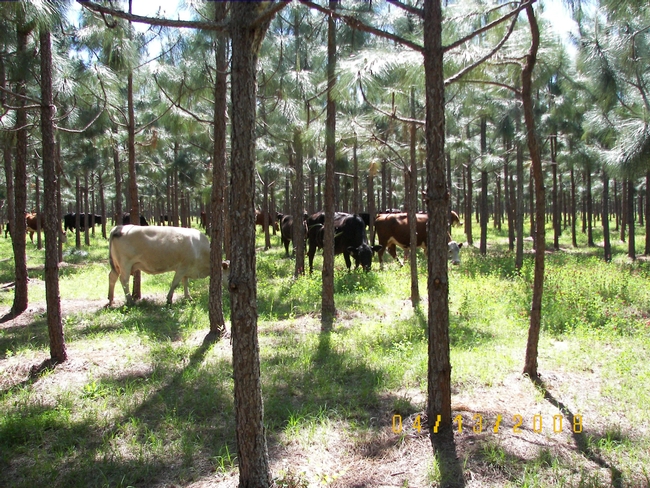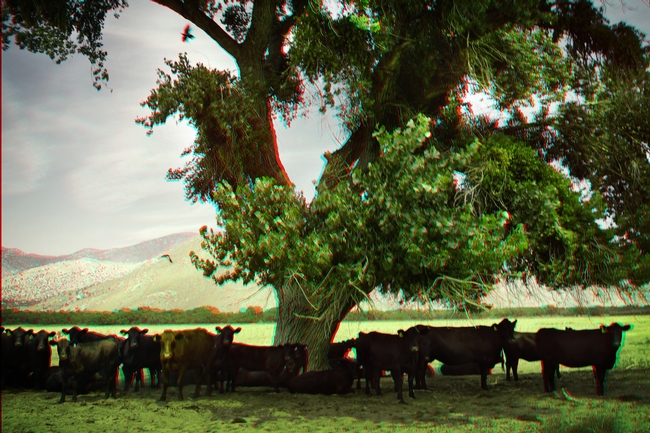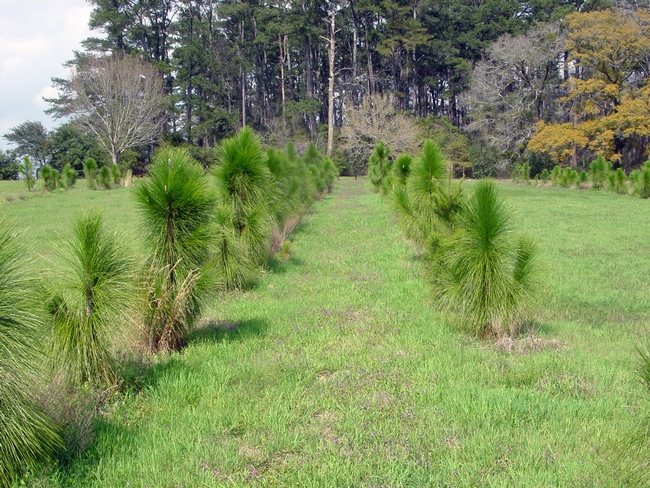Authors: Alli Fish and Niki Mazaroli, Strategy Research Science
Silvopasture is the intentional and intensive combination of trees, forage, and livestock on the same piece of land. The applicability and potential benefit of silvopasture to both ranchlands and orchards – two agricultural landscapes that dominate the region – adds to its promise as a climate-smart agriculture practice in Santa Barbara and Ventura Counties.
Over 80% of land in Ventura County and over 90% in Santa Barbara County is either being grazed or has the potential to be grazed. [1] And while silvopasture systems will not be suitable for all of the nearly 2 million acres of rangeland, silvopasture has great potential to support both livestock production and ecological health in the region.
What qualifies as silvopasture?
To put it simply, there are two approaches to establishing a silvopasture system: adding trees to pasture or adding animals to tree systems. Tree systems can include natural forests, timber plantations, and orchards.A key piece to the definition of silvopasture according to the USDA is that the combination of pasture, trees, and animals must be intentional and managed as a system, as opposed to “individual practices that occur coincidentally together or managed independently.” [2]
A key piece to managing a productive silvopasture system is rotational grazing, a livestock and pasture management practice that has been shown to greatly improve soil health when implemented correctly. Rotational grazing is also essential to maintaining the health of the pasture and minimizing damage to trees, especially young trees. Once trees are established and above browsing height, which varies depending on the grazing animals, this is less of a factor. However, the combination of animal and edible tree crops triggers important food safety regulations that must be considered early on in the design of any silvopasture system. (See “Regulations” below.)

What are the potential benefits of silvopasture as a climate-smart agriculture practice?
The NRCS recognizes silvopasture as a multi-purpose conservation practice that can:
- Provide forage, shade, and/or shelter for livestock.
- Improve the productivity and health of trees/shrubs and forages.
- Improve water quality.
- Reduce erosion.
- Enhance wildlife habitat.
- Improve biological diversity.
- Improve soil quality.
- Increase carbon sequestration and storage.
- Provide habitat for beneficial organisms and pollinators. [3]
In terms of a producer's economic bottom line, silvopasture can be a way of diversifying revenue. For example, the shorter-term income from grazing livestock can buffer or offset the upfront cost of establishing trees and shrubs onto existing pasture. [4]

Challenges and considerations
While formulaic in its definition, the actual practice of silvopasture is extremely site-specific, like most things in farming and ranching. The limitations of the land and the market opportunities available will inform the desired and required tree crop, forage, and livestock of the system.
And while there is consensus on the potential benefits of silvopasture, there isn't one single model – one combination of trees, forage, and livestock – that can inform all silvopasture operations.
Instead, there are many factors to consider when planning a silvopasture system, and most of them are interrelated:
- Regulations: Regulations are particularly tricky for silvopasture systems producing edible tree crops (i.e. fruit and nut trees). To comply with the GAP and NOP standards, raw manure cannot be applied 90 day before harvest of crops not in contact with the ground (i.e. many fruits crops) and 120 day for crops in contact with the ground (i.e. all row crops, and some tree crops). Farms with annual revenue greater than $500,000 and/or that sell majority of product beyond 275 miles must also comply with additional regulations as part of the Food Safety Modernization Act (FSMA). [5] Note that some packinghouses have agreed to only take fruit that is GAP certified. It is important to understand where any edible crops you will be producing will be sold and any associated food safety requirements before beginning or converting to silvopasture.
- Management skills and labor: Livestock producers must learn to manage trees, and, conversely, growers must learn to care for livestock. Additional infrastructure (potentially lots of fencing!) and labor to start up and maintain a rotational grazing system.
- Tree selection and system design: Depending on your existing operation and goals, you might prioritize fast growing trees that produce forage and aren't as delicate to livestock damage; or you might select tree crops or timber trees that are slower growing but have the potential to generate more revenue over time. Whether or not you own your land and, if you lease land, the terms of your lease may also influence the trees you chose to plant and your silvopasture plan overall.
- Source of forage: Will the trees and shrubs be a source of the forage or another crop to sell? Or both! Unharvested fruit and nuts can be consumed by livestock and a source of increased soil fertility when deposited as manure.
Are you practicing silvopasture in Santa Barbara or Ventura counties? If so, let us know! We are interested in learning more about the opportunities and challenges that local producers face when implementing and managing these systems.
If you have plans for integrating silvopasture on your farm to help meet your soil health goals, consider applying for funding through the California Department of Food and Agriculture's Healthy Soils Program. Grant applications are expected to open early February 2020, you can stay up to date with email notifications and by checking the website: https://www.cdfa.ca.gov/oefi/healthysoils/. If you have questions or would like technical assistance on the grant process, please contact your local technical assistance provider at http://ciwr.ucanr.edu/Programs/ClimateSmartAg/TechnicalAssistanceProviders/.

Citations:
[1] California Gap Analysis Project “GAP”: California Fish and Wildlife Service and UCSB
[2] Brantly, S. What Silvopasture?—Working Trees. USDA National Agroforestry Center; 2013. Available online:https://www.fs.usda.gov/nac/assets/documents/workingtrees/infosheets/WhatIsSilvopastureInfoSheetMay2013.pdf. Accessed on 10 Dec 2019.
[3] USDA NRCS. Silvopasture (Code 381) Conservation Practice Standard. Pennsylvania. 2016. Available online: https://www.nrcs.usda.gov/wps/PA_NRCSConsumption/download?cid=stelprdb1255015&ext=pdf. Accessed on 1 Dec 2019.
[4] USDA NAC. Silvopasture. USDA National Agroforestry Center. 2019. Available online: https://www.fs.usda.gov/nac/practices/silvopasture.php. Accessed on 1 Dec 2019.
[5] Gabriel, S. Silvopasture: A Guide to Managing Grazing Animals, Forage Crops, and Trees in a Temperate Farm Ecosystem. Chelsea Green Publishing, 2018.